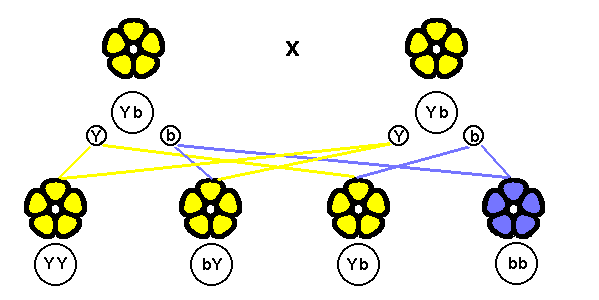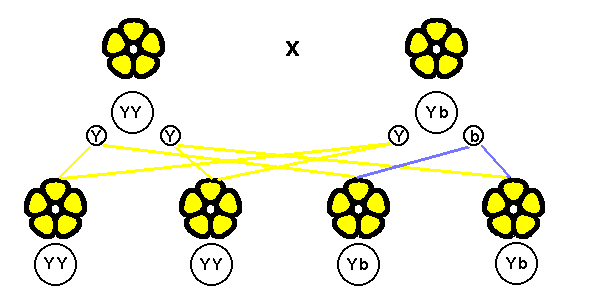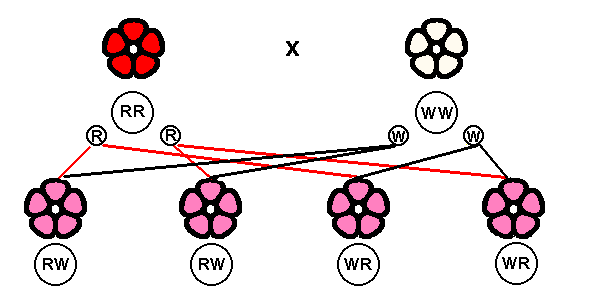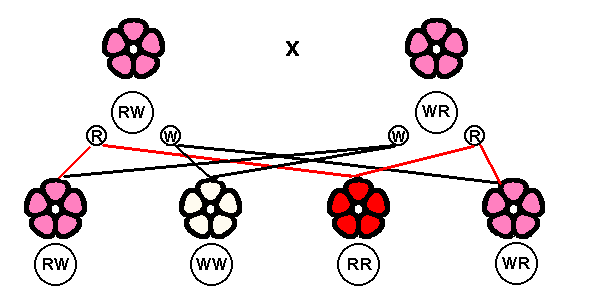Gardeners grow a lot of hybrid plants, although they often mean particular types of hybrids when they use the word. Strictly, a hybrid is the result of crossing any two individuals which have different genes, so almost any individual plant in a population is a hybrid. If you grow several Aquilegias or Lupins in your garden, the plants produced from their seeds will often be a different colour from the parent plants. This is because what you see is not what you get. A pink or yellow flower may be carrying genes for, say, blue or white flowers, and when these genes combine in the seed, the resulting plant may have blue or white flowers although the parents may not be these colours. What the plant looks like is its phenotype, and what its genes make it is its genotype. Because seeds often contain genes for other colours, the plants you get from crossing hybrids do not always come true to the parent plants. The same applies to other characteristics such as the size of the flowers or the height of the plants. Because a population of plants contains a mixture of genes for several characteristics, the plants resulting from mixing all these characteristics have a variety of colours and sizes.
For example, a yellow Aquilegia might cross with a pink Aquilegia, and the seeds might give us a plant with a blue flower. This diagram shows how this can happen:

We can see that the yellow flower was only the phenotype, and the plant's DNA also included a recessive gene for blue flowers. Similarly, the plant with pink flowers also included a recessive gene for blue flowers. If the gene for pink flowers is a dominant gene, and the gene for yellow flowers is a dominant gene, neither will have priority over the other in the next generation; they are co-dominant. When the genes combine in the seed, the next generation gives us a pink-flowered plant where the pink gene is dominant, a yellow-flowered plant where the yellow gene is dominant, a blue-flowered plant where there are only genes for blue flowers, and an orange-flowered plant where neither pink nor yellow is dominant.
Selective Breeding
Sometimes, we like to have a mixture of plants in our garden. Sometimes, we prefer to know what we are likely to get from our seeds. There are two ways in which people can have more control over what the seeds of their plants produce. The first is to select plants with the characteristic you want - say, pink flowers, and then to allow only the plants with pink flowers to produce seeds, and to go on doing this for several generations of plants. After several generations, most of the genes for other colour flowers will have been 'bred out', and most of the seeds will produce plants with pink flowers. This is called 'selective breeding', and is how we got most of our named hybrids, and many of them come fairly true from seed. There may still be a few genes for other colours left, and now and again, when they meet with other similar genes, a different plant may be produced.
In selective breeding, plants are usually selected on the basis of what they look like, their phenotype. One of the problems with using this method to get the characteristic you want in the next generation is that there might be a recessive gene which will give a different phenotype in the next generation. For instance, crossing two yellow aquilegias with genes as in the above example would not give us 100% yellow-flowered plants. We would get 75% yellow flowers, and 25% blue flowers, as this diagram shows:
In the next generation, we would get 100% yellow flowers, because the genes for yellow flowers are dominant, so even when there is a gene for blue flowers, it does not show in the flowers. The phenotype is yellow for all the plants of this generation, and 50% of the plants have a yellow genotype.
F1 Hybrids
The other way to control what the next generation of plants looks like is to rely on F1 hybrids. These are the first filial generation of plants produced from a particular cross. Growers choose plants that have already been selectively bred for several generations, so that they know that genes for the characteristics they don't want have already been bred out of the plants. Crossing two plants to get a particular characteristic in all of the offspring follows Mendel's First Law, the Principle of Uniflormity. This means that all the offspring of plants which differ in just one characteristic will be the same in that characteristic. So if the breeders cross a plant with red flowers with a plant with white flowers, if the genes for each colour are equally dominant, the result will be that all the flowers of the next generation, the F1 plants, will have pink flowers. Knowing that all the plants produced from a packet of seeds will be what you want is one of the attractions of using F1 hybrids. The diagram below illustrates this:
Seeds saved from F1 hybrids will not produce plants identical to the parent plants. The same plants can only be produced by crossing exactly the same type of pollen parent plant with exactly the same seed parent plant. This is why F1 hybrids are so expensive. The growers have to remove the stamens from every individual plant they want to use as a seed parent to prevent it from being fertilised by its own pollen. And unless we know exactly which plants they used as male and female parents, we cannot make the same cross in our own gardens.
The plants we get from the seed saved from F1 hybrids will produce a mixture of plants, because the available genes can mix in different combinations. In the next generation, called the F2 generation, 50% of the plants will inherit the particular combination of genes desired, 25% will have one gene for it, and 25% will have the other gene, where neither is dominant. The diagrams below show why this is.
In practice, plants are usually selected or crossed to try and produce a single plant with a number of desirable characteristics, such as bigger fruit, longer flowering season, more compact growth, and so on, carried by several genes in the DNA, so hybridising is even more complicated than the diagrams above indicate.
Giving Plants More Genes
Normal plants have two sets of chromosomes which divide when the cells are preparing to pass on their DNA to their offspring in their pollen (male parent plant) or ovules (female parent plant). They are diploid organisms. Sometimes, the chromosomes do not split in two, but a duplicate set of chromosomes is produced for each cell division, so that the new individual has twice the number of chromosomes it should. This is called polyploidy. If there are three times the normal number of chromosomes, a plant is triploid, four times is tetraploid. These changes can sometimes occur naturally, but scientists have found that they can prevent cell division and make the plant keep all the chromosomes in one cell by using colchicine. If there is an even number of chromosome sets in a plant, it can reproduce in the normal way, because there is an even number of chromosome sets to link together, but triploid plants have an odd number of sets, so they are sterile.
Some hybrids show better rates of growth or fertility, and this is called Hybrid Vigour or heterosis. It is usually the result of having more genes for a characteristic than normal, but because the genes pair up normally in the next generation, hybrid vigour is usually only applicable to the first generation of these hybrids.
More about Flower Colour
Mendel used peas with red and white flowers for many of his studies, and it was a lucky choice, because the flower colour in future generations could be followed easily. In many flowers, it is not the colour of the flowers but the individual pigments which make up the colours which is inherited. There are two types of pigments: flavonoids and carotenoids. Flavonoids include anthocyanins which make flowers pink, red or purple, and flavonol which makes them white or cream. Carotenoids are found in yellow or orange flowers. Different amounts of these individual pigments produce different colours in a flower, and the colour is also affected by the presence of various metals, and by the pH of the flower sap, which might depend on the type of soil the plant is grown in. It is therefore not as simple as crossing plants with flowers of two particular colours to produce a desired colour as if they were paints. Not all pigments are found in all plants, and, apart from a trace recently found in one type of fruit in the Rose family, the pigment delphinidin, which is necessary to get blue flowers, has not been found in either roses or carnations.
What an individual inherits from its parents is also more complicated than a straight yes or no for any particular characteristic. Sometimes, several different genes need to be present for a particular characteristic to show, so obviously how many of them and in what degree they occur in an individual can provide a large number of variations in that characteristic in succeeding generations.
Whether we rely on the natural hybridisation that occurs from open pollination of plants in our gardens, select and grow plants for particular characteristics, or grow only the first generation of particular crosses, most gardeners increase the variety of plants in their gardens by growing hybrids.
There's more about the technicalities of genes here.



